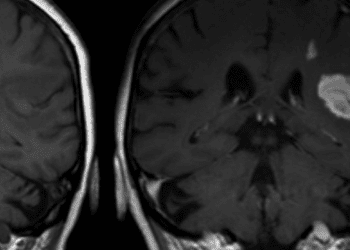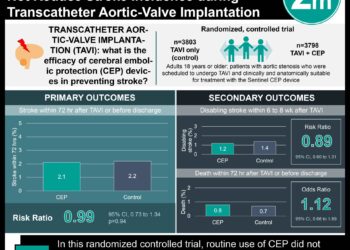2 Minute Medicine Rewind November 8, 2021
Association between melanoma detected during routine skin checks and mortality
1. In a large cohort from Australia, melanomas diagnosed through routine skin checks were associated with reduced all-cause mortality, but not melanoma-specific mortality.
Evidence Rating Level: 2 (Good)
Diagnosis of melanoma at earlier stages is associated with better survival and thus reduces healthcare burden. Observational studies have found that whole-body skin examinations are associated with decreased melanoma mortality and fewer thick melanomas. However, very few countries have implemented screening programs for melanoma. Thus, this cohort study aimed to assess melanoma-specific and all-cause mortality associated with melanoma identified through routine skin checks, incidentally, or through patient detection. It analyzed data from 2452 patients, of which 858 (35%) were diagnosed due to a routine skin check, 1148 (47%) self-detected their lesion, 293 (12%) had their melanoma discovered incidentally when checking another skin lesion and 153 (6%) reported “other” presentation. The median age at diagnosis was 65 years and 1502 (61%) of the patients were men. Detection of invasive melanoma through routine skin-check was associated with 59% lower melanoma-specific mortality (hazard ratio, 0.41; 95% CI, 0.28 – 0.60; p < 0.001) and 36% lower all-cause mortality (hazard ratio, 0.64; 95% CI, 0.54 – 0.76; p < 0.001), compared to patient-detected melanomas. However, after adjusting for prognostication factors the association to melanoma-specific mortality became non-significant (hazard ratio, 0.68; 95% CI, 0.44 – 1.03; p = 0.13) while the all-cause mortality remained significant (hazard ratio, 0.75; 95% CI, 0.63 – 0.90; p = 0.006). Therefore, the study concluded that although melanomas diagnosed through routine skin-checks were associated with significantly lower all-cause mortality, they did not impact melanoma specific mortality. Future studies with improved methodologies, specifically randomized controlled trials, are needed to confirm these results.
Risk of Guillain-Barré Syndrome following recombinant zoster vaccine in medicare beneficiaries
1. In a cohort of Medicare beneficiaries, the recombinant zoster vaccine was associated with a slightly increased risk of Guillain-Barré Syndrome.
Evidence Rating Level: 2 (Good)
After evaluation of vaccinations for herpes zoster, the recombinant zoster vaccine (RZV) was recommended over the zoster vaccine live (ZVL) for prevention. Guillain-Barré Syndrome is an immune-mediate polyneuropathy that has been reported following certain vaccinations, including RZV. Therefore, this retrospective cohort study aimed to investigate GBS risk after receiving the RZV vaccine. The study utilized data from Medicare enrollment and claims databases. It identified a total of 1,318,004 recipients of RZV vaccinations and 1,817,099 patients who received ZVL vaccinations. Amongst RZV recipients, the mean age was 74.8 years and 58% were female whereas those receiving the ZVL vaccine had a mean age of 74.3 and 60% were female. It was found that GBS risk after RZV is increased compared to ZVL (RR, 2.34; 95% CI, 1.01 – 5.41; p = 0.047. The study also performed a self-controlled case series analysis for those receiving RZV. A risk window was defined as 1 to 42 days postvaccination and served as a “case”, while the control window was defined as 43 to 183 days postvaccination. It was found that there was an increased risk of GBS in the risk window compared to the control window (RR, 4.30; 95% CI, 1.76 – 10.53; p = 0.001). The secondary analysis found an increased risk of GBS after the first RZV dose (RR, 9.30; 95% CI, 3.00 – 28.84; p <0.001). There were 9.50 excess cases (95% CI, 4.35 – 14.66; p <0.001) for every million vaccinations administered. Therefore, the study concluded that there may be a slightly increased risk of GBS for 42 days following RZV vaccination, however, these should be measured against risk of herpes zoster and its complications. This was a well-powered study and thus helps to answer an important clinical question.
1. In patients COVID-19, the combination of inhaled and intranasal ciclesonide did not show a statistically significant improvement of respiratory symptoms.
Evidence Rating Level: 1 (Excellent)
COVID-19 has represented a significant cause of morbidity and mortality since its emergence. Respiratory symptoms tend to be commonly present in those infected with this virus. Ciclesonide is a corticosteroid used in inhaled form to treat asthma and intranasally to treat allergic rhinitis. This randomised controlled trial aimed to evaluate whether early administration of ciclesonide decreases respiratory symptoms in adults with COVID-19. 203 participants were randomized to either inhaled and intranasal ciclesonide (n=105) or inhaled and intranasal saline placebo (n=98). The median age of participants was 35 years (interquartile range 27 – 46 years) and 109 (54%) were female. All included participants had confirmed covid-19 and at least one of the following symptoms: fever, cough, shortness of breath, chest congestion, or chest tightness). The primary outcome was defined as resolution of self-reported fever and all respiratory symptoms at day 7 of treatment. It was found that the proportion of participants with resolved symptoms by day 7 did not differ significantly between the intervention group (n = 42 from 105; 40%) and control group (n = 34 from 98; 35%). The adjusted risk difference was 5.5% (95% CI, -7.8% – 18.8%). The secondary outcomes included were hospital admission, death due to COVID-19, and resolution of symptoms by day 14. There were no statistically significant differences found in any of these outcomes. No deaths occurred during this study. 69 of 105 (66%) patients had resolution in the intervention group compared to 57 of 98 (58%) in placebo group, with an adjusted risk difference of 7.5% (95% CI, -5.9% – 20.8%). Therefore, the study concluded that younger healthier populations with COVID-19 did not improve respiratory symptoms. As this is one of the only trials focusing on this population, future directions for research should include examining different classes of inhaled corticosteroids to determine their effects.
1. In children with type 1 diabetes, diabetic ketoacidosis is not associated with poor long-term metabolic control.
Evidence Rating Level: 2 (Good)
Diabetic ketoacidosis (DKA), although often preventable, is the most common complication of newly diagnosed type 1 diabetes (T1D). Some studies have demonstrated that DKA present at time of diagnosis is associated with longer hospitalization and higher insulin requirements. Therefore, this retrospective cohort study aimed to evaluate whether children with T1D who had DKA have worse glycemic control compared to those who do not. The study matched 85 participants with T1D who had DKA at onset of the disease to 85 participants without DKA at diagnosis in a one-to-one ratio. The mean age at diagnosis for participants with DKA was 7.93 years and the pH on recognition was 7.19 compared to the group without DKA that had a mean age of 7.63 years and pH of 7.39. The study defined different degrees of acidosis as mild, moderate, and severe (pH < 7.3, < 7.2, < 7.1, respectively). The primary outcome measured was the comparison of HbA1c between the group with DKA and without DKA. It was found that HbA1c at onset of diabetes was statistically higher in children with DKA (p < 0.001) with maximum values reported in children with severe DKA (HbA1c = 13.25%). The study found a sharp decline in the HbA1c levels after the first year following diagnosis in both groups. Thereafter, the HbA1c levels remained relatively stable throughout the 5-year follow-up period. There were no statistically significant differences found in the HbA1c levels when comparing those who had DKA and those who did not (HbA1c (%) at 1 year, 7.10 vs. 6.80, p = 0.233; HbA1c (%) at 2 years, 7.00 vs. 7.10, p = 0.676; HbA1c (%) at 3 years, 7.20 vs. 7.20, p = 0.522; HbA1c (%) at 4 years, 7.40 vs. 7.30, p = 0.983; HbA1c (%) at 5 year, 7.20 vs 7.30, p = 0.413). The secondary outcomes measured were total daily dose of insulin (TDD), basal rate, and body-mass index. There were no statistically significant differences found in these outcomes between the two groups. Therefore, the study concluded that the presence of DKA at diabetes diagnosis is not associated with poor long-term outcomes. Although this study answers an important clinical question, larger-scale studies that account for confounding factors such as socioeconomics are needed to support this conclusion.
Sex differences in cardiovascular outcomes of older adults after myocardial infarction
1. In a cohort of older Finnish adults, men had an increased long-term risk of adverse cardiovascular events after a myocardial infarction compared to women.
Evidence Rating Level: 2 (Good)
Myocardial infarctions (MI) are a leading cause of morbidity and mortality worldwide. Despite this, there are limited studies on acute coronary syndromes including older patients. Specifically, although short-term mortality after MI has been studied in this population, there is limited evidence on long-term outcomes. Therefore, this retrospective cohort study aimed to evaluate the sex differences in long-term cardiovascular outcomes after MI in older adults. It made use of data from international registries and all patients with MI >70 years admitted to 20 hospitals were followed for a 10-year period. The studied included 31,578 patients (59% men; mean age = 79 years). All outcomes were measured for 10 years, beginning at 90 days after index MI. The primary outcome measured was a composite major adverse cardiovascular event (MACE) such as new MI, ischemic stroke, or cardiovascular death. It was found that MACE occurred in 8508 men and 7620 women during the follow-up period. The incidence of MACE was 18.6% in men versus 15.8% in women after the 1-year follow-up (p < 0.0001), 47.0% in men versus 41.9% in women after the 5-year follow-up (p < 0.0001), and 67.7% in men versus 62.0% in women at the end of the 10-year follow-up (hazard ratio (HR), 1.17; 95% CI, 1.13 – 1.21, p < 0.0001). The secondary outcomes measured were cardiovascular death, new MI, and ischemic stroke. At the 10-year follow-up, the incidence of new MI was 37.0% in men and 33.1% in women (HR, 1.16; CI, 1.11–1.21; p < 0.0001). Similarly, the incidence of cardiovascular death was 56.0% in men versus 51.1% in women at the10‐year follow‐up (HR, 1.18; CI, 1.13–1.22; p < 0.0001). Lastly, the incidence of ischemic stroke was 21.1% in men versus 19.5% in women at 10 years (HR, 1.10; CI, 1.03–1.18; p = 0.004). Therefore, the study concluded older men had worse long-term cardiovascular prognoses after MI compared to women. This well-designed and well-powered study brings forward new information that may impact clinical decision-making in the future.
Image: PD
©2021 2 Minute Medicine, Inc. All rights reserved. No works may be reproduced without expressed written consent from 2 Minute Medicine, Inc. Inquire about licensing here. No article should be construed as medical advice and is not intended as such by the authors or by 2 Minute Medicine, Inc.







